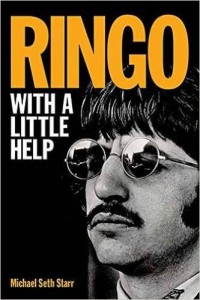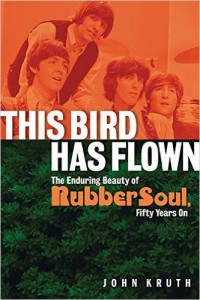The Beatles Book Round Ups
It’s been a while since we updated the Sonic Bandwagon bookshelf, but suddenly a couple of titles appear and we go all retro. There must be quite a few Beatles titles dotted around the Ainscoe bookshelves. For a start there’s Philip Norman’s famous ‘Shout’ biography – one of the first Beatles books I read, and of course a couple of marvellously detailed, some would say encyclopaedic, large format works by Beatles chronicler Mark Lewisohn, covering both their studio sessions and then almost a day by day account of their existence. One of my favourites which I read in the late eighties was a fascinating account, called, ‘Waiting For The Beatles’, by Carol Bedford, one of the so called ‘Apple scruffs’ who used to hang outside the studio as the guys recorded, just for a glimpse (or more as we learn through her story) of the boys. Ray Coleman was one of the writers who biographed Lennon and I’m sure there must be a similar McCartney work in there too. Despite George Harrison’s near as dammit autobiography, ‘I, Me Mine’, the ‘other’ Beatle got less of a share of the book treatment. Until now.
 ‘RINGO – WITH A LITTLE HELP’
‘RINGO – WITH A LITTLE HELP’
Michael Seth Starr
Backbeat Books
First things first. And as he is at pains to point out himself very early on, Michael Seth Starr is no relation. Good selling point though as he launches on his mission to bring the story of the man who is very possibly the most famous in rock and roll. When you’re known simply by a single name (Prince, Madonna, Elvis, Bono…) it adds that element of notoriety.
There’s a very healthy set of notes to ably demonstrate the depth of research – after all, there are plenty of sources for good copy for our subject. Plus there are a few words from fellow tub thumpers, who make light of the idea that Ringo was just one of those everyday run of the mill drummer guys who got a lucky break.
Inevitably, given the subject matter, there’s a healthy chunk devoted to Ringo’s Beatles days – one of those which class as the greatest story ever told, and told many times by many people, without certain embellishments. The interest lies in the years beyond. After all, 1969 to present day is a more than a mass of time covering some forty odd years and a lot of water under the bridge.
Naturally, Starr, the author, spends time plotting the post-Beatles career which had its fair share of musical successes, albeit not exactly at the cutting edge, more warm and friendly and likeable just like the man himself. There are plentiful references to the personal demons which found their way into the Starr lifestyle; certain influences making their presence felt. Chapters entitled, “We were junkies dabbling in music” and “Getting out of bed’s a problem these days” (and not just drugs but the reliance on alcohol) show the author isn’t afraid to broach some of the more difficult areas, and do some digging to reveal a full picture.
Things do seem to come full circle, visions of mortality maybe as his brothers start to fall, but with the evolution of the All Starr Band as a musical vehicle seemingly giving Ringo a new direction, the mojo gets sparked again. These days he’s flashing the peace signs, full of love and peace just as his old buddy Lennon used to do, and he’s in reasonably rude health – which for rock stars in the current climate is saying something. Ultimately a wealthy man, and in his own words, “nice to be part of history.”
 ‘THIS BIRD HAS FLOWN – The enduring beauty of ‘Rubber Soul’ fifty years on’
‘THIS BIRD HAS FLOWN – The enduring beauty of ‘Rubber Soul’ fifty years on’
John Kruth
Backbeat Books
It says something for the longevity and appeal of an album when you can fill a book about it. There have been others – Led Zep’s fourth album has had the same treatment, as has The Beatles own ground breaking, ‘Revolver’. There’s no doubt that one of the fascinating things about The Beatles was their progression. From ‘Love Me Do’ to ‘Abbey Road’ in seven years via ‘Revolver’ and ‘Sgt Pepper’, not to mention the fashions and the hairstyles was a remarkably intense period.
Sandwiched between ‘Help!’ and ‘Revolver’ in the mid sixties, ‘Rubber Soul’ might seem an odd one to choose from the Beatles’ catalogue, yet it was perhaps the album that saw The Beatles at the turning point and significant that it was the one which led them to ‘Revolver’ – perhaps their most key album if not their greatest album, the jury is still out – and ‘Pepper’. The times indeed, were a-changin’.
Fab Four devotees will already appreciate the weird inconsistencies between the UK and the US releases. The US starts off with ‘I’ve Just Seen A Face’ (released in the UK on the previous ‘Help!’ album) – an attempt maybe as suggested to launch the album as a more folk related record. After all, the Dylan and The Byrds influence was kicking in as well as the marketing ploys which with a band like The Beatles, were of the utmost value. The US absence of ‘Drive My Car’ and ‘Nowhere Man’, two major songs in the Fab Four canon is similarly mystifying, but back to the book, which delivers both context and song by song examination.
Some twenty songs of the ‘Rubber Soul’ period get a thorough analysis as well as each getting a dedicated and amusingly titled ‘Rubber covers’, where brief cover versions of the song are explored, possibly only scratching the surface, but revealing some interesting takes. Some songs get plenty wordage and trail off into other related areas – the twenty pages of the ‘Norwegian Wood’ chapter not surprisingly drifts into sitar territory, and the influence of Dylan, while the ‘In My Life’ chapter further examines the mystery of the fifth Beatle. Again, the jury might be out, although the majority verdict would surely grant George Martin the honour.
Matched up with Mark Lewisohn’s ‘Complete Recording Sessions’ for the period, ‘This Bird Has Flown’ might not provide anything new in terms of actual recording detail, but fleshes out the picture of the period; the surprising thing being that we’re talking about music, an album and its songs from fifty years ago.






